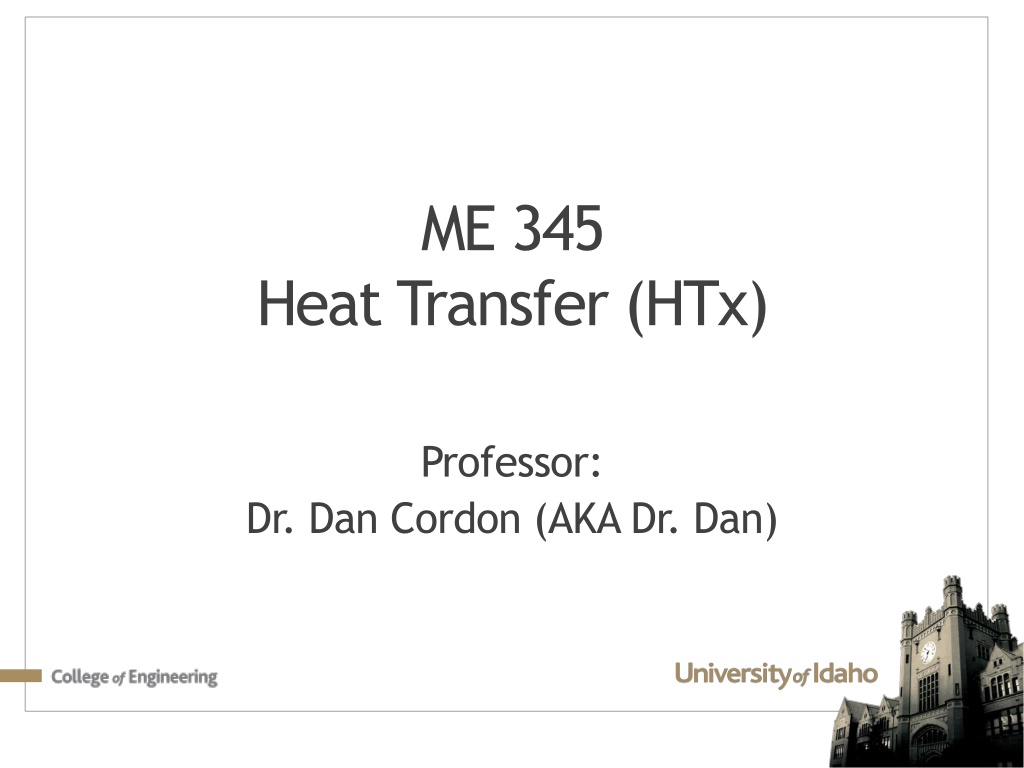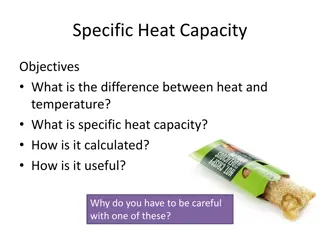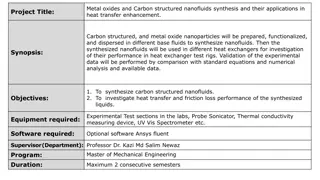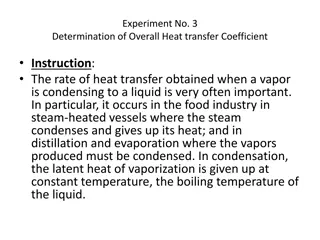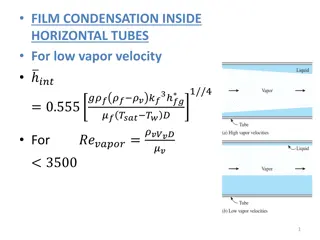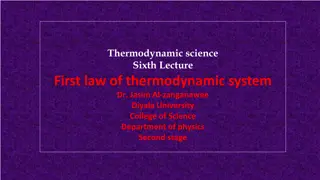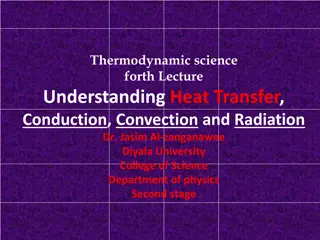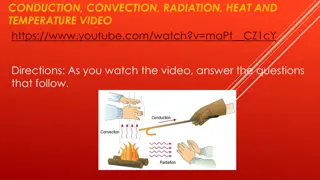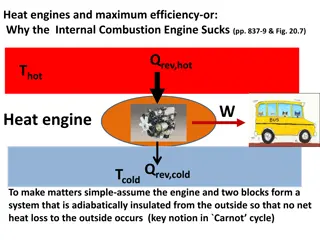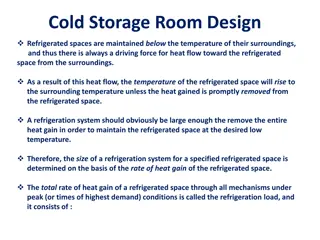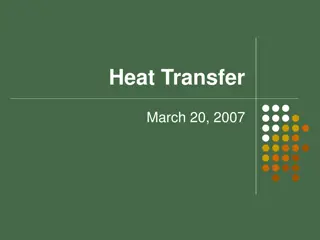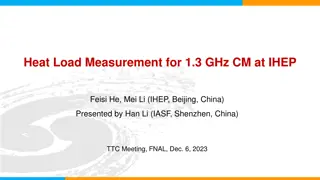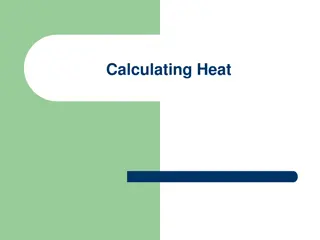Understanding Internal Flow in Heat Transfer Processes
Exploring internal flow characteristics in heat transfer, we delve into topics like laminar flow, velocity profiles, Reynolds number, and entry lengths for different flow regimes. Images illustrate concepts such as fully developed velocity profiles and the impact of flow conditions on the mean velocity. Understanding these fundamentals is crucial for optimizing heat transfer systems.
Download Presentation

Please find below an Image/Link to download the presentation.
The content on the website is provided AS IS for your information and personal use only. It may not be sold, licensed, or shared on other websites without obtaining consent from the author. Download presentation by click this link. If you encounter any issues during the download, it is possible that the publisher has removed the file from their server.
E N D
Presentation Transcript
ME 345 Heat Transfer (HTx) Professor: Dr. Dan Cordon (AKA Dr. Dan)
INTERNAL FLOW - VELOCITY Laminar flow enters a circular pipe with uniform velocity. Viscous effects slow the flow near the wall and a boundary layer begins to form. Xfd, h is the hydrodynamic entry length the length at which the flow reaches the fully developed region.
INTERNAL FLOW - VELOCITY Once laminar flow is fully developed the velocity profile will be parabolic in the radial direction and will no longer change as a function of distance down the pipe. Note: Peak velocity in fully developed region is notably higher than the original incoming velocity!
INTERNAL FLOW REYNOLDS NUMBER For flow in pipes the Reynolds Number is: For circular pipe/tube ???= 4 ? ??? Where um is the mean velocity over the cross section, and D is the tube diameter. For fully developed flow the critical Reynolds Number corresponding to the onset of turbulence is generally recognized as: However, fully turbulent conditions usually don t occur until closer to With high Reynolds Numbers the transition to turbulent flow is likely to begin in the region of developing flow
ENTRY LENGTH For laminar flow the hydrodynamic entry length can be found from the equation: This means that for some laminar flows it may take slightly over 100 diameters downstream from the entrance for the flow to become fully developed! For turbulent flow there isn t a nice equation, but the general rule of thumb is the hydrodynamic entry length will be: Or somewhere around 10-60 diameters downstream the flow will be fully developed.
VELOCITY PROFILE - LAMINAR For laminar flow the mean velocity will be roughly half the peak velocity in the center. Velocity profile is roughly: Where um is the mean velocity, which is calculated from knowing the mass flow rate and diameter. Laminar Profile Turbulent Profile
VELOCITY PROFILE - TURBULENT For turbulent flow the mean velocity is only slightly lower than peak velocity in the center. 1 ? ?(?) ??= 1 ? ?0 Velocity profile is roughly: Where n depends on the friction factor such that: Usually n~7 1 ?= ? ??? ? < 0.1 Laminar Profile Turbulent Profile
FRICTION FACTOR The friction factor (f) is used to determine pressure drop in a over a pipe. You probably remember this from the Moody (or Darcy) Diagram. This is *not* the same as the friction coefficient (Cf) But the two are related by: For fully developed laminar flow we use the relationship:
FRICTION FACTOR For turbulent flow things get much more complicated. There are a few equations that approximate the friction factor, but the Moody Diagram is still the gold standard.
PRESSURE DROP and POWER Correlating pressure drop in a pipe with friction factor is done by separating and integrating: To get: 2 ? = ?1 ?2= ???? ?2 ?1 2? Power required to move the flow over this pressure drop can be calculated by: ? ? ????? = ? ? = ?
INTERNAL FLOW - THERMAL Let s consider thermal conditions of a laminar flow entering a circular pipe with uniform velocity. Xfd, t is the thermal entry length can be found by:
COMPARING ENTRY LENGTH Hydrodynamic Thermal For turbulent flow there is no difference between the hydrodynamic and thermal entry lengths: 10 ? ???, ???,? ? ???? 60 10 ???? 60 If the Prandtl Number is greater than 1 the velocity boundary layer develops before the thermal boundary layer. If the Prandtl Number is less than 1 the thermal boundary layer develops before the velocity boundary layer.
MEAN TEMPERATURE Just as there was a mean velocity we also need to find a mean temperature. This represents an average temperature across the cross section. Note: Tm will change with distance down the tube increasing if Ts>Tm or decreasing if Ts<Tm ?0 2 ??= 2 ? ?,? ? ?,? ? ?? ???0 0 And we can use Tmin Newton s Law of Cooling as a way to relate the local heat flux to the local convection coefficient.
FULLY DEVELOPED MEAN TEMPERATURE Fully developed hydrodynamic flow existed when the velocity profile remained constant down the length of the tube. If heat transfer is occurring at the surface of the tube the average temperature will never remain constant. However, once fully developed the shape of the temperature *will* remain constant, even if the mean temperature is changing down the length of the tube. The implications are that once fully developed the convection coefficient will remain constant down the remainder of the tube.
ENERGY BALANCE If heat transfer is occurring in the tube then Tm will change as a function of x. We want to know how Tm will be changing. An energy balance will show that: And with a substitution and a little algebra we can show: Where P is the perimeter. For a tube of constant cross section the term ?/ ??? will remain constant. Tm(x) depends on the thermal conditions at the surface
CONSTANT HEAT FLUX If there is constant heat flux at the surface (electrical heating, or similar) we can integrate dTm/dx to find: Temperature down the length of tube will look like: In the entry region (Ts - Tm) is increasing due to changes in h Once fully developed (Ts - Tm) is constant
CONSTANT SURFACE TEMPERATURE If the surface is held at constant temperature we can separate and integrate the energy balance equation to find: Where is the average value of h from the inlet to x (distance down the pipe) Temperature down the length of tube will look like: (Ts - Tm) will be constantly changing down the length of the tube.
LOG MEAN TEMPERATURE DIFFERENCE To calculate the heat transferred for a length of pipe we can simplify the equation by introducing a new T If we define: (LMTD) then we can find the heat transfer rate in the tube as: Cases where Ts are constant are very common. There is a fluid on the outside of the tube with constant temperature (air outside a radiator) A large thermal sink (think about a ground-sourced heat pump)
EXAMPLE 8.2 Find the following:
EXAMPLE 8.2 Since the outside is wrapped in adiabatic insulation we know all the electrical heat generated must go into the water. Set these equal to each other and solve for L:
EXAMPLE 8.2 Newton s Law of Cooling at the outlet looks like: And we can get surface heat flux from: So the local convection coefficient at the outlet would have to be:
EXAMPLE 8.2 Some interesting tidbits If the flow is fully developed by the exit of the tube: (Ts - Tm) will be constant from the moment the flow is fully developed to the exit. Calculating um and ReD we get: um = 0.32 m/sec ReD = 9145 Nearly fully-turbulent flow. 10 diameters = 0.2 m after inlet 60 diameters = 1.2 m after inlet Of the 17.7 m pipe necessary, 16.5-17.5 m is fully developed
EXAMPLE 8.2 More interesting tidbits Since the electrical energy would have created a constant heat flux we could have also used to calculate the length necessary
EXAMPLE 8.3 We know the rate of heat from convection in the pipe is: And we also know that for constant surface temperature the rate of heat from convection is:
EXAMPLE 8.3 Calculating LMTD Calculating average convection coefficient
